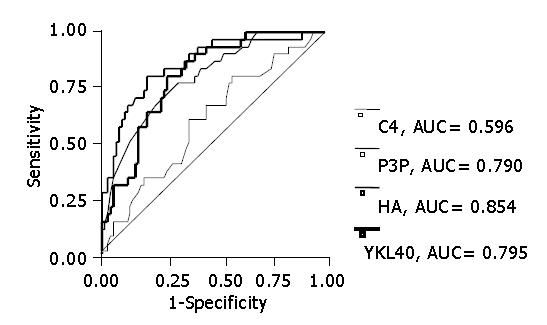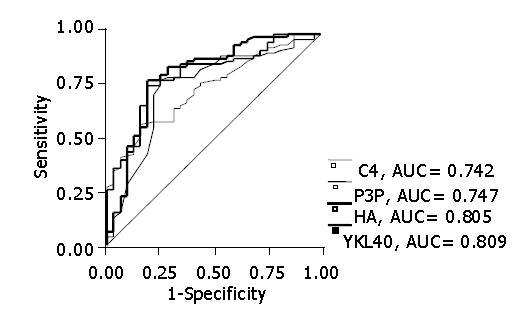Copyright
©2005 Baishideng Publishing Group Inc.
World J Gastroenterol. Jan 28, 2005; 11(4): 476-481
Published online Jan 28, 2005. doi: 10.3748/wjg.v11.i4.476
Published online Jan 28, 2005. doi: 10.3748/wjg.v11.i4.476
Figure 1 Serum levels of type IV collagen, PIIIP, HA and YKL-40 with respect to stage of liver fibrosis (F0-4).
The box represents the interquartile range. The whiskers indicate the highest and lowest values, and the line across the box indicates the median value. Overall significance of differences among 5 groups was determined by ANOVA: for type IV collagen, F = 9.076, P<0.0001; for PIIIP, F = 9.636, P<0.0001; for HA, F = 13.128, P<0.0001; and for YKL-40, F = 8.016, P<0.0001.
Figure 2 Receiver operating curves of type IV collagen, PIIIP, HA and YKL-40 for predicting stages greater than F3.
The predictive ability of serum HA exceeded that of another serum markers (AUC = 0.854). The ability to predict cirrhosis (F4) from chronic hepatitis C (F0-3) was AUC = 0.795 for YKL-40 and AUC = 0.790 for PIIIP.
Figure 3 Receiver operating curves of type IV collagen, PIIIP, HA and YKL-40 for predicting stages greater than F1.
YKL-40 and HA exceeded those of PIIIP and type IV collagen (YKL-40, AUC = 0.809; HA, AUC = 0.805).
Figure 4 Serum levels of type IV collagen, PIIIP, HA and YKL-40 before and 6 months after IFN therapy in NVR and SVR patient groups.
The box represents the interquartile range. The whiskers indicate the highest and lowest values, and the line across the box indicates the median value. The levels of all serum markers without type IV collagen 6 mo after IFN treatment were lower than those before IFN treatment in SVR group (aP<0.05), while only YKL-40 levels decreased in NVR group (aP<0.05).
- Citation: Saitou Y, Shiraki K, Yamanaka Y, Yamaguchi Y, Kawakita T, Yamamoto N, Sugimoto K, Murata K, Nakano T. Noninvasive estimation of liver fibrosis and response to interferon therapy by a serum fibrogenesis marker, YKL-40, in patients with HCV-associated liver disease. World J Gastroenterol 2005; 11(4): 476-481
- URL: https://www.wjgnet.com/1007-9327/full/v11/i4/476.htm
- DOI: https://dx.doi.org/10.3748/wjg.v11.i4.476












